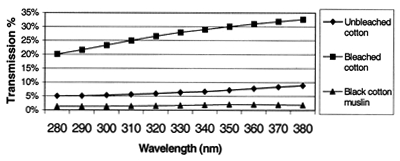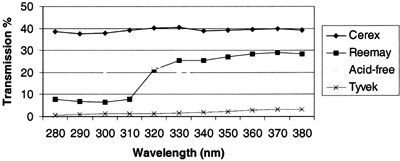ABILITY OF TEXTILE COVERS TO PROTECT ARTIFACTS FROM ULTRAVIOLET RADIATIONNANCY KERR, LINDA CAPJACK, & ROBERT FEDOSEJEVS
3 3. RESULTS AND DISCUSSIONWhen incident radiation contacts a fabric (fig. 2), part of that radiation is scattered from the surface and the remainder is absorbed by or penetrates through the fabric. A fraction of the radiation passes through the fibers and spaces between the yarns. The absorbed radiation is taken up by the chromophores in the fibers as well as by other materials present (dyes, delustrants, optical brighteners, finishes). A fabric's ability to protect museum objects or items from ultraviolet light in conservation laboratories, historic houses, storage areas, or limited-view exhibits can be increased by selecting fibers, dyes, and finishes that have excellent absorption of UV radiation. The effect of a variety of fiber types, fabric constructions, dye, and pigment on the transmission of UV is reported in table 1. Fabrics 1 to 9 in table 1 vary in fiber content, but all are undyed, plain-weave fabrics made from spun yarns. It should be noted that the UV transmission values represent the “worst case” or maximum values because they are obtained by passing UV rays in a direction perpendicular to the plane of the cloth. Incident light during use may not be perpendicular to the fabric surface, but may contact it at an angle, thereby increasing the scattering and effective cover.
3.1 3.1 EFFECT OF FABRIC PARAMETERS ON UV TRANSMISSIONThe fiber composition of a fabric affects UV transmission. The poly (ethylene terephthalate) polyester fabric (#8) listed in table 1 had an average transmission of 12% over the 280–380 nm range and was a more effective UV blocker than all but the unbleached cotton muslins. Poly (ethylene terephthalate)-type polyester contains phenyl ester groups that are known to exhibit a very strong UV absorption below 310 nm. Synthetic fibers spun from aliphatic polymers such as nylon, acrylic, and polypropylene block little UV radiation unless they are delustered or dyed. The presence of titanium dioxide delustering pigment in the acrylic, polyester, nylon, Reemay polyester, and Tyvek polypropylene samples contributed to the blocking of UV radiation by these fabrics. Titanium dioxide absorbs about 90% of the incident radiation uniformly across the UV region 280–380 nm (Thomson 1986), and has an absorption maximum at approximately 350 nm (Reinert et al. 1997). Fabric mass and cover also affect UV transmission. Among the fabrics shown in table 1, those with the highest mass transmitted the least UV radiation; for example, black fabrics nos. 16, 17, and 18 transmitted 1.1, 0.3, and 0.1% UV, respectively. Their low transmission was also a function of their color, thickness, and high cover (98-99%). Other researchers (Berne and Fischer 1980; Pailthorpe 1993) have also noted that high mass and cover resulted in low UV transmission values. Davis (1995) found that the relationship between UV transmission and cover is not as strong as mass. A fabric with high cover does not necessarily block UV rays effectively because some transmission occurs through the fibers or yarns as well as the spaces between them; for example, fabric #10, an undelustered Cerex nonwoven, has a cover of 83% and an open area of 17%. The UV transmission of this fabric is 39%, showing that UV radiation is not only passing through the open area but also penetrating the fibers. 3.2 3.2 UV TRANSMISSION THROUGH TYPICAL MUSEUM FABRICS AND ACID-FREE TISSUEThe UV transmission and other physical characteristics of fabrics frequently used as light and dust covers are presented in table 1, entries 1–3 and 10–15. Cotton is known to be a weak absorber of UV once the natural pigment is removed by bleaching (Pailthorpe 1993; Reinert et al. 1997). This observation is consistent with data obtained for UV transmission by two unbleached muslins (nos. 1 and 2), which, though they differ substantially in mass, had almost identical transmissions of 6% and 7%, respectively. The much greater (27%) UV transmission of fabric no. 3, a bleached cotton muslin, even though it has a cover and mass similar to those of muslin no. 2, is also in agreement with Reinert's suggestion. Figure 3 shows the difference in transmission of UV through bleached, unbleached, and dyed-black cotton muslin.
Cerex nylon spunbonded web (no. 10) is typically used to separate textiles in storage, to line trays, and to protect items from dust. It provides little protection from UV radiation, however, transmitting about 40% of the incident radiation. Figure 4 shows the variation in transmission of UV with wavelength through Cerex and Reemay fabrics, SB polyester, and acid-free tissue. Other researchers have noted the permeability of aliphatic nylons to UV radiation over the whole UV region (Reinert et al. 1997).
Among the spunbonded nonwovens made of nylon, polyester, and polypropylene, the most effective UV screen was the Tyvek SB polypropylene (no. 12), which transmitted 2% of the UV radiation. This spunbonded nonwoven is a water-resistant, flexible material typical of the “synthetic paper” that is used in the conservation laboratory as a cover for rolled textiles in storage, curtains in storage areas, and covers for objects that are undergoing conservation treatments. The reason Tyvek blocks the transmission of UV radiation so well is its fiber content, its high cover (98%), and the heavy pigmentation of the fibers. 3.3 3.3 DYED FABRICSOur research (Davis 1995; Davis et al. 1997) and that of many others (Pailthorpe 1993; Gies et al. 1994; Pailthorpe 1994; Reinert et al. 1997) has shown that fabrics dyed dark shades or saturated colors rather than pastels are very effective at screening UV radiation. Five black fabrics are shown in table 1 to illustrate this finding. The black fabric that transmitted the most UV (6.1%) was a low-mass, thin 65/35 polyester/cotton fabric (no. 14), and yet it blocked as much UV as the most effective UV-blocking fabric in the undyed group, a heavy unbleached muslin (no. 1). Three of the knitted black fabrics in this group (nos. 16–18) transmitted only 1% of the UV, thereby meeting Thomson's criterion for an effective UV filter (Thomson 1986). Their effectiveness is a combination of color as well as high thickness, mass, and cover, resulting from the knit structure. If black fabrics are used in a conservation laboratory or museum setting to protect objects from light, they should first be tested for colorfastness to crocking and water. |
|||||||||||||||||||||||||||||||||||||||||||||||||||||||||||||||||||||||||||||||||||||||||||||||||||||||||||||||||||||||||||||||


